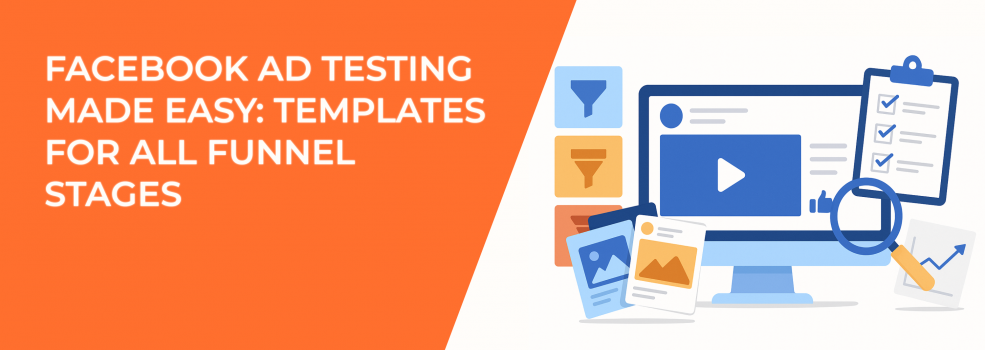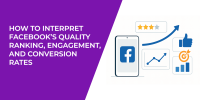You’ve heard it before — testing is essential to Facebook ad success. But most advertisers don’t test with structure. They throw variations at the wall, hope one sticks, and get frustrated when results plateau.
What if your testing process actually aligned with how people buy? What if your ad experiments matched where prospects are in their decision-making journey?
This is the core idea behind funnel-based testing: building Facebook ad campaigns around what people need to hear and when they’re ready to hear it.
Let’s unpack how to test ads at each stage of your funnel — Awareness, Consideration, and Conversion — and explore plug-and-play templates that help you create smarter experiments, faster.
Why Funnel-Specific Testing Drives Better Results
When you serve ads that don’t fit the user’s mindset, you waste budget and data. The early-stage buyer who doesn’t know your brand won’t respond to a 10% off coupon. And a warm lead already familiar with your product doesn’t need a basic explainer.
Every stage of your marketing funnel represents a shift in user intent. That means your ad tests must evolve, too.
Funnel-aligned testing helps you:
-
Optimize ad spend by only showing relevant content at each stage.
-
Increase test clarity, since you isolate variables for the right audience.
-
Shorten the sales cycle with messaging that anticipates the user’s next step.
-
Gather cleaner, more actionable performance data.
Now, let’s dig into how to approach each funnel stage — with strategies, use cases, and practical templates you can apply today.
If you need a structured approach to mapping your funnel before testing ads at each stage, this Facebook Ads funnel strategy guide lays out the full blueprint.
Awareness Stage: Testing for Attention and Curiosity
At the top of the funnel, users aren’t looking for your product — they’re just scrolling. Your challenge? Break through the noise and give them a reason to care.
This stage is about disruption, intrigue, and fast comprehension.
What to test:
-
Hook styles: Test bold questions, surprising facts, short emotional statements, or curiosity gaps (e.g., “You’re applying moisturizer wrong — here’s why.”).
-
Creative formats: Try static images, short-form video, animated text, or full-screen Reels.
-
Brand vs. benefit-first messaging: Are users more drawn to your story — or what you solve?
Actionable strategy: use the “3 Creative Angles” method. Instead of endlessly tweaking headlines or colors, create three radically different approaches to the same offer. For example:
-
Problem-first angle: Highlight a pain point users may recognize immediately.
-
Lifestyle angle: Show the transformation your product enables.
-
Curiosity angle: Lead with a question or teaser that begs for a click.
Run all three under one campaign but separate ad sets. This gives each a fair chance to gain traction without Facebook’s algorithm prematurely favoring one.
Success metrics to watch:
-
Click-through rate (CTR).
-
3-second and 15-second video views.
-
Cost-per-landing page view (if tracking).
-
Engagement rate (comments, shares, reactions).
At this stage, you’re not aiming for conversions — you’re hunting for attention. If the CTR is low across the board, go back to the creative drawing board.
To craft awareness ads that actually grab attention, learn how to apply the psychology of Facebook ads to your hook and headline testing.
Consideration Stage: Testing for Education and Persuasion
Now that users are aware of your brand, they’re open to learning more. This is your chance to build trust, provide value, and answer early objections — all through targeted testing.
This stage focuses on clarity, confidence, and relevance.
What to test:
-
Explainer videos vs. testimonial clips: Is a product walkthrough more persuasive than a happy customer story?
-
Carousel vs. single-image ads: Does an interactive format increase click depth?
-
Educational lead-ins vs. persuasive copy: Do your users respond better to data or emotional language?
Actionable strategy:
Build your Content Test Matrix by mixing format + angle combinations. Here's how:
-
Choose 2 ad formats (e.g., carousel and video).
-
Choose 2 angles (e.g., feature highlight and social proof).
-
Create one ad for each pairing — for a total of 4 ads.
This controlled variety helps you pinpoint what style and message resonate best with your mid-funnel audience.
Use custom audiences to segment traffic from your Awareness campaigns. Test these ads only on users who watched your previous videos or visited your website in the last 30 days.
Success metrics to watch:
-
Cost-per-click (CPC).
-
Time on site or scroll depth (via landing page tools).
-
Add-to-cart or product view rates.
-
Comment quality — are users asking questions, tagging friends, or expressing interest?
If users engage but don’t move forward, try layering urgency or exclusivity in your messaging or simplify your landing page flow.
Conversion Stage: Testing for Action and Clarity
This is the final mile. Your audience knows you. They’ve considered you. Now, they’re hovering on the edge of buying. The right test here can mean a huge lift in revenue.
Your goal at this stage: remove friction and increase confidence.
What to test:
-
Offers: Try percentage discounts, free shipping, limited-time bonuses, or bundled packages.
-
Call-to-action (CTA) language: Test “Buy Now” vs. “Try Risk-Free” vs. “Unlock 15% Off.”
-
Retargeting creative types: Static urgency banners vs. personal testimonial videos.
Actionable strategy:
Run a Sequential Retargeting Campaign using time-based custom audiences. For example:
-
Day 0–3: Serve high-intent testimonials or offer reminders.
-
Day 4–7: Add urgency (e.g., “Last chance to get 15% off”).
-
Day 8–14: Try risk-reversal messaging (e.g., “100% money-back guarantee”).
This sequencing allows you to test messaging cadence as much as creative variation. You’ll see what pace your users respond to and when the drop-off happens.
Test one variable at a time. If you're adjusting your discount and changing the image, you won’t know which one moved the needle.
Success metrics to watch:
-
Cost per purchase (CPP).
-
Conversion rate from retargeting campaigns.
-
Frequency (overexposure can kill performance).
-
Landing page bounce rate and cart abandonment.
If your metrics are solid but performance stalls over time, refresh creative regularly to avoid ad fatigue. Even your best ad has an expiration date.
Still not seeing purchases or leads despite strong engagement? You might be missing one key fix — here’s how to troubleshoot a low-converting ad.
Bonus: Testing Infrastructure Tips That Save Budget and Time
Want better results from your tests? Build a smarter testing environment. Here’s how:
-
Use separate campaigns by funnel stage. Don’t mix Awareness and Conversion ads in one ad set. Keep data clean and decisions clear.
-
Avoid Advantage Campaign Budget (CBO) in early tests. Facebook’s algorithm can kill slower performers too fast. Use ad set budgets for controlled testing, then scale winning ads under CBO.
-
Schedule test windows. Let new ads run for 3–5 days before analyzing. Premature decisions skew data and kill promising creatives.
-
Maintain a Creative Tracker. Document every ad variant, the stage it served, and its performance. This helps identify repeat winners (or avoid past flops).
-
Refresh ads before performance dips. Don’t wait for a high-frequency warning — rotate top ads every 7–10 days to stay ahead of fatigue.
These habits don’t just help your current campaigns — they build a long-term testing culture. The more structured your environment, the easier it becomes to scale with confidence, not guesswork.
Final Thoughts: Test for Insight, Not Just Results
Most Facebook advertisers test ads to find what “works.” But the smarter ones? They test to understand why it works — and how to do it again.
When you align your testing to the funnel, you don’t just optimize campaigns — you build a more intelligent marketing system. One that listens to the buyer’s journey. One that speaks in context. One that performs better, with less waste.
So the next time you launch a test, ask yourself:
-
Where is this audience in their journey?
-
What do they need to believe to take the next step?
-
Am I testing the right message — or just the loudest one?
That’s the mindset that leads to results you can actually scale.

